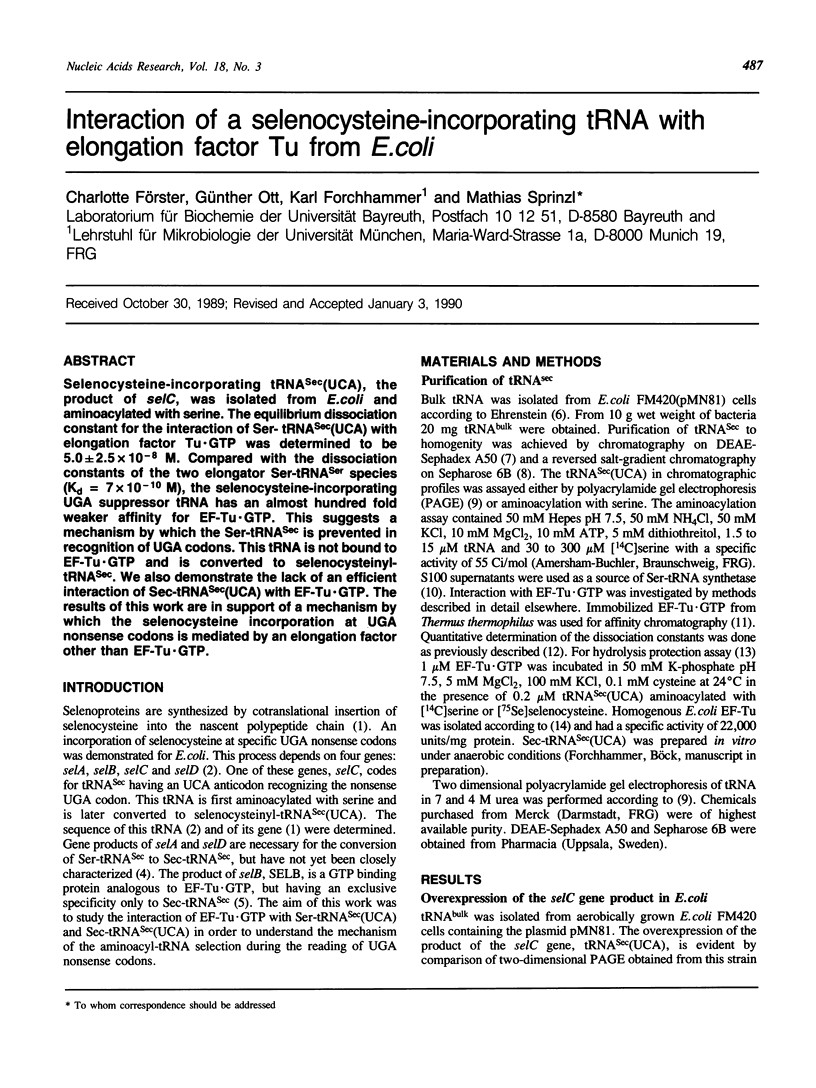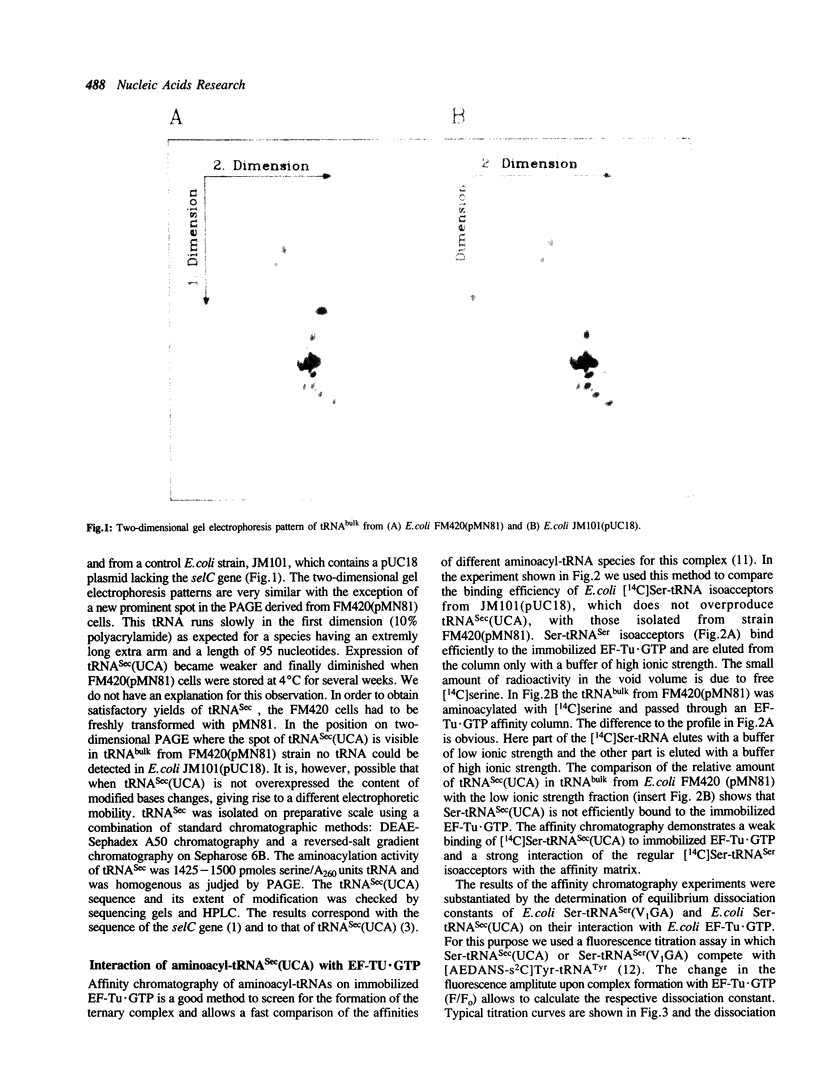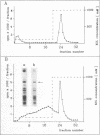Abstract
Selenocysteine-incorporating tRNA(Sec)(UCA), the product of selC, was isolated from E.coli and aminoacylated with serine. The equilibrium dissociation constant for the interaction of Ser-tRNA(Sec)(UCA) with elongation factor Tu.GTP was determined to be 5.0 +/- 2.5 x 10(-8) M. Compared with the dissociation constants of the two elongator Ser-tRNA(Ser) species (Kd = 7 x 10(-10) M), the selenocysteine-incorporating UGA suppressor tRNA has an almost hundred fold weaker affinity for EF-Tu.GTP. This suggests a mechanism by which the Ser-tRNA(Sec) is prevented in recognition of UGA codons. This tRNA is not bound to EF-Tu.GTP and is converted to selenocysteinyl-tRNA(Sec). We also demonstrate the lack of an efficient interaction of Sec-tRNA(Sec)(UCA) with EF-Tu.GTP. The results of this work are in support of a mechanism by which the selenocysteine incorporation at UGA nonsense codons is mediated by an elongation factor other than EF-Tu.GTP.
Full text
PDF




Images in this article
Selected References
These references are in PubMed. This may not be the complete list of references from this article.
- Beres L., Lucas-Lenard J. Studies on the fluorescence of the Y base of yeast phenylalanine transfer ribonucleic acid. Effect of pH, aminoacylation, and interaction with elongation factor Tu. Biochemistry. 1973 Sep 25;12(20):3998–4002. doi: 10.1021/bi00744a033. [DOI] [PubMed] [Google Scholar]
- Derwenskus K. H., Fischer W., Sprinzl M. Isolation of tRNA isoacceptors by affinity chromatography on immobilized bacterial elongation factor Tu. Anal Biochem. 1984 Jan;136(1):161–167. doi: 10.1016/0003-2697(84)90318-x. [DOI] [PubMed] [Google Scholar]
- Fradin A., Gruhl H., Feldmann H. Mapping of yeast tRNAs by two-dimensional electrophoresis on polyacrylamide gels. FEBS Lett. 1975 Feb 1;50(2):185–189. doi: 10.1016/0014-5793(75)80485-6. [DOI] [PubMed] [Google Scholar]
- Holmes W. M., Hurd R. E., Reid B. R., Rimerman R. A., Hatfield G. W. Separation of transfer ribonucleic acid by sepharose chromatography using reverse salt gradients. Proc Natl Acad Sci U S A. 1975 Mar;72(3):1068–1071. doi: 10.1073/pnas.72.3.1068. [DOI] [PMC free article] [PubMed] [Google Scholar]
- Joshi R. L., Faulhammer H., Chapeville F., Sprinzl M., Haenni A. L. Aminoacyl RNA domain of turnip yellow mosaic virus Val-RNA interacting with elongation factor Tu. Nucleic Acids Res. 1984 Oct 11;12(19):7467–7478. doi: 10.1093/nar/12.19.7467. [DOI] [PMC free article] [PubMed] [Google Scholar]
- Leberman R., Antonsson B., Giovanelli R., Guariguata R., Schumann R., Wittinghofer A. A simplified procedure for the isolation of bacterial polypeptide elongation factor EF-Tu. Anal Biochem. 1980 May 1;104(1):29–36. doi: 10.1016/0003-2697(80)90272-9. [DOI] [PubMed] [Google Scholar]
- Leinfelder W., Stadtman T. C., Böck A. Occurrence in vivo of selenocysteyl-tRNA(SERUCA) in Escherichia coli. Effect of sel mutations. J Biol Chem. 1989 Jun 15;264(17):9720–9723. [PubMed] [Google Scholar]
- Leinfelder W., Zehelein E., Mandrand-Berthelot M. A., Böck A. Gene for a novel tRNA species that accepts L-serine and cotranslationally inserts selenocysteine. Nature. 1988 Feb 25;331(6158):723–725. doi: 10.1038/331723a0. [DOI] [PubMed] [Google Scholar]
- Louie A., Jurnak F. Kinetic studies of Escherichia coli elongation factor Tu-guanosine 5'-triphosphate-aminoacyl-tRNA complexes. Biochemistry. 1985 Nov 5;24(23):6433–6439. doi: 10.1021/bi00344a019. [DOI] [PubMed] [Google Scholar]
- Ott G., Faulhammer H. G., Sprinzl M. Interaction of elongation factor Tu from Escherichia coli with aminoacyl-tRNA carrying a fluorescent reporter group on the 3' terminus. Eur J Biochem. 1989 Sep 15;184(2):345–352. doi: 10.1111/j.1432-1033.1989.tb15025.x. [DOI] [PubMed] [Google Scholar]
- Pingoud A., Urbanke C., Krauss G., Peters F., Maass G. Ternary complex formation between elongation factor Tu, GTP and aminoacyl-tRNA: an equilibrium study. Eur J Biochem. 1977 Sep;78(2):403–409. doi: 10.1111/j.1432-1033.1977.tb11752.x. [DOI] [PubMed] [Google Scholar]
- Schön A., Böck A., Ott G., Sprinzl M., Söll D. The selenocysteine-inserting opal suppressor serine tRNA from E. coli is highly unusual in structure and modification. Nucleic Acids Res. 1989 Sep 25;17(18):7159–7165. doi: 10.1093/nar/17.18.7159. [DOI] [PMC free article] [PubMed] [Google Scholar]
- Sprinzl M., Hartmann T., Weber J., Blank J., Zeidler R. Compilation of tRNA sequences and sequences of tRNA genes. Nucleic Acids Res. 1989;17 (Suppl):r1–172. doi: 10.1093/nar/17.suppl.r1. [DOI] [PMC free article] [PubMed] [Google Scholar]
- Tanada S., Kawakami M., Nishio K., Takemura S. Interaction of aminoacyl-tRNA with bacterial elongation factor Tu: GTP complex: effects of the amino group of amino acid esterified to tRNA, the amino acid side chain, and tRNA structure. J Biochem. 1982 Jan;91(1):291–299. doi: 10.1093/oxfordjournals.jbchem.a133687. [DOI] [PubMed] [Google Scholar]
- Wagner T., Sprinzl M. Enzymic binding of aminoacyl-tRNA to Escherichia coli ribosomes using modified tRNA species and tRNA fragments. Methods Enzymol. 1979;60:615–628. doi: 10.1016/s0076-6879(79)60058-7. [DOI] [PubMed] [Google Scholar]
- Zinoni F., Birkmann A., Leinfelder W., Böck A. Cotranslational insertion of selenocysteine into formate dehydrogenase from Escherichia coli directed by a UGA codon. Proc Natl Acad Sci U S A. 1987 May;84(10):3156–3160. doi: 10.1073/pnas.84.10.3156. [DOI] [PMC free article] [PubMed] [Google Scholar]




